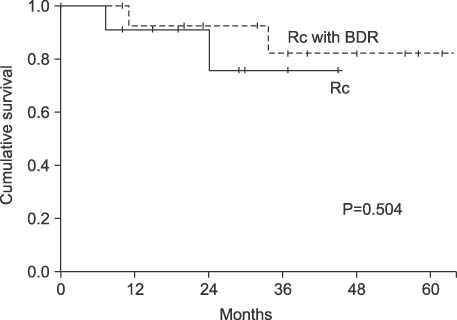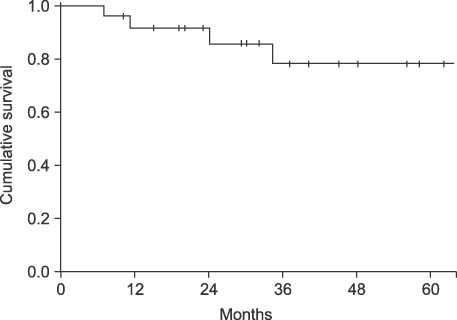J Korean Surg Soc.
2009 Aug;77(2):113-119. 10.4174/jkss.2009.77.2.113.
Should the Extrahepatic Bile Duct be Resected for T2 Gallbladder Cancer?
- Affiliations
-
- 1Department of Surgery, Yeungnam University Medical Center, Daegu, Korea. HJK@med.yu.ac.kr
- KMID: 2211290
- DOI: http://doi.org/10.4174/jkss.2009.77.2.113
Abstract
- PURPOSE
The prognosis of advanced gallbladder cancer remains unfortunate. Yet, the prognostic factors and the efficacy of extrahepatic bile duct resection remain unclear. The adequacy for extrahepatic bile duct resection for T2 gallbladder cancer, according to the characteristics of either the clinicopathological factors or the prognostic factors, was evaluated. METHODS: One hundred and one patients with gallbladder cancer underwent surgical resection at Yeungnam University Medical Center (YUMC) between January 2001 and July 2008. A retrospective analysis was conducted on 26 patients with pathologic stage T2. RESULTS: 7 of the 26 patients with T2 disease (26.9%) had lymph node metastasis. Of the 7 patients with lymph node metastasis, 3 patients underwent radical cholecystectomy (RC), and 4 patients underwent radical cholecystectomy combined with extrahepatic bile duct resection (RC+BDR). The 1-year and 3-year survival rate of patients that underwent RC was 66.7% and 0% and patients that underwent RC+BDR was 50.0% and 0%, respectively (P=0.433). Even with microscopic vascular invasion or perineural invasion, RC+BDR did not provide any survival advantage compared with RC in T2 gallbladder cancer. Prognostic factors for patients with T2 gallbladder cancer was total bilirubin level, lymph node metastasis, differentiation of tumor, microscopic vascular invasion and perineural invasion. CONCLUSION: For patients with T2 gallbladder cancer, RC is recommended, even with the presence of lymph node metastasis, microvascular invasion or perineural invasion. Resection of the extrahepatic bile duct is indicated for patients with T2 gallbladder cancer with involvement of the cystic duct or invasion of the hepatoduodenal ligament.
Keyword
MeSH Terms
Figure
Reference
-
1. Jemal A, Siegel R, Ward E, Murray T, Xu J, Smigal C, et al. Cancer statistics, 2006. CA Cancer J Clin. 2006. 56:106–130.2. Baxter I, Garden OJ. Surgical palliation of carcinoma of the gallbladder. Hepatogastroenterology. 1999. 46:1572–1577.3. Lim SB, Kim KH, Kim SW, Yoon YB, Park YH. A clinical study of prognostic factors in gallbladder cancer. J Korean Surg Soc. 1998. 55:120–131.4. Lee HS, Kim KS, Choi JS, Lee SH, Lee WJ, Kim BR. Gallbladder carcinoma diagnosed after laparoscopic cholecystectomy. Korean J Hepatobiliary Pancreat Surg. 2002. 6:73–79.5. Muratore A, Polastri R, Capussotti L. Radical surgery for gallbladder cancer: current options. Eur J Surg Oncol. 2000. 26:438–443.6. Yamaguchi K, Chijiiwa K, Saiki S, Nishihara K, Takashima M, Kawakami K, et al. Retrospective analysis of 70 operations for gallbladder carcinoma. Br J Surg. 1997. 84:200–204.7. Shimada H, Endo I, Togo S, Nakano A, Izumi T, Nakagawara G. The role of lymph node dissection in the treatment of gallbladder carcinoma. Cancer. 1997. 79:892–899.8. Tsukada K, Kurosaki I, Uchida K, Shirai Y, Oohashi Y, Yokoyama N, et al. Lymph node spread from carcinoma of the gallbladder. Cancer. 1997. 80:661–667.9. Goetze T, Paolucci V. Does laparoscopy worsen the prognosis for incidental gallbladder cancer? Surg Endosc. 2006. 20:286–293.10. Bartlett DL, Fong Y, Fortner JG, Brennan MF, Blumgart LH. Long-term results after resection for gallbladder cancer. Implications for staging and management. Ann Surg. 1996. 224:639–646.11. Chan CP, Chang HC, Chen YL, Yang LH, Chen ST, Kuo SJ, et al. A 10-year experience of unsuspected gallbladder cancer after laparoscopic cholecystectomy. Int Surg. 2003. 88:175–179.12. Chijiiwa K, Tanaka M. Carcinoma of the gallbladder: an appraisal of surgical resection. Surgery. 1994. 115:751–756.13. Cubertafond P, Gainant A, Cucchiaro G. Surgical treatment of 724 carcinomas of the gallbladder. Results of the French Surgical Association Survey. Ann Surg. 1994. 219:275–280.14. Benoist S, Panis Y, Fagniez PL. Long-term results after curative resection for carcinoma of the gallbladder. French University Association for Surgical Research. Am J Surg. 1998. 175:118–122.15. Fong Y, Jarnagin W, Blumgart LH. Gallbladder cancer: comparison of patients presenting initially for definitive operation with those presenting after prior noncurative intervention. Ann Surg. 2000. 232:557–569.16. Tsukada K, Hatakeyama K, Kurosaki I, Uchida K, Shirai Y, Muto T, et al. Outcome of radical surgery for carcinoma of the gallbladder according to the TNM stage. Surgery. 1996. 120:816–821.17. Oertli D, Herzog U, Tondelli P. Primary carcinoma of the gallbladder: operative experience during a 16 year period. Eur J Surg. 1993. 159:415–420.18. Ono T, Komatsu M, Hoshino T, Ishii T, Fujii T, Oshima S, et al. Alpha-fetoprotein, carcinoembryonic antigen, and carbohydrate antigen 19-9-producing gallbladder cancer. J Gastroenterol. 1996. 31:742–746.19. Strom BL, Maislin G, West SL, Atkinson B, Herlyn M, Saul S, et al. Serum CEA and CA 19-9: potential future diagnostic or screening tests for gallbladder cancer? Int J Cancer. 1990. 5:821–824.20. Chijiiwa K, Nakano K, Ueda J, Noshiro H, Nagai E, Yamaguchi K, et al. Surgical treatment of patients with T2 gallbladder carcinoma invading the subserosal layer. J Am Coll Surg. 2001. 192:600–607.21. Yildirim E, Celen O, Gulben K, Berberoglu U. The surgical management of incidental gallbladder carcinoma. Eur J Surg Oncol. 2005. 31:45–52.22. Kosuge T, Sano K, Shimada K, Yamamoto J, Yamasaki S, Makuuchi M. Should the bile duct be preserved or removed in radical surgery for gallbladder cancer? Hepatogastroenterology. 1999. 46:2133–2137.23. Shirai Y, Yoshida K, Tsukada K, Muto T, Watanabe H. Radical surgery for gallbladder carcinoma. Long-term results. Ann Surg. 1992. 216:565–568.24. Shirai Y, Yoshida K, Tsukada K, Muto T. Inapparent carcinoma of the gallbladder. An appraisal of a radical second operation after simple cholecystectomy. Ann Surg. 1992. 215:326–331.25. Kim KS, Lee WJ, Kim HG, Chi HS, Kim BR. Gallbladder cancer incidentally discovered after a laparoscopic cholecystectomy. J Korean Surg Soc. 1998. 54:1024–1031.26. Box JC, Edge SB. Laparoscopic cholecystectomy and unsuspected gallbladder carcinoma. Semin Surg Oncol. 1999. 16:327–331.27. Shimizu Y, Ohtsuka M, Ito H, Kimura F, Shimizu H, Togawa A, et al. Should the extrahepatic bile duct be resected for locally advanced gallbladder cancer? Surgery. 2004. 136:1012–1017.28. Suzuki S, Yokoi Y, Kurachi K, Inaba K, Ota S, Azuma M, et al. Appraisal of surgical treatment for pT2 gallbladder carcinomas. World J Surg. 2004. 28:160–165.
- Full Text Links
- Actions
-
Cited
- CITED
-
- Close
- Share
- Similar articles
-
- Incidence, mortality and survival of gallbladder, extrahepatic bile duct, and pancreatic cancer using Korea central cancer registry database: 1999-2019
- Clinical Review of Carcinomas of the Extrahepatic Bile Ducts and Gallbladders
- Concurrent Yellow-to-white and Black Extrahepatic Bile Duct Stones
- Extrahepatic Bile Duct Duplication with Intraductal Papillary Neoplasm: A Case Report
- Introduction of 7th AJCC Cancer Staging: Gallbladder, Perihilar Bile Duct and Distal Common Bile Duct



